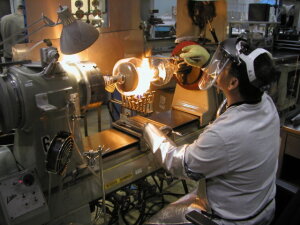by
Joan Trombetti, Writer | February 11, 2008

Dunlee worker sealing
in a glass CT tube,
he's bringing the
anode and cathode
together to make
a glass frame.
This article is from in the January 2008 issue of DOTmed Business News. A list of registered users that provide sales & service can be found at the end.
Medical imaging is one of the biggest industries in healthcare, and there are many companies in this diverse and competitive marketplace. Some are part of the technology-driven world of X-ray tubes and Image Intensifiers (II). For those OEMs and third party providers - the global market is over a billion dollars. Without question, tubes and intensifiers are critical components in X-ray imaging equipment. When they need to be replaced, buyers may have a service contract with the original seller, or they may need to look at other options. Depending on the type of X-ray tube or II and where it's purchased - and whether it's purchased new or refurbished -- prices range in the thousands to hundreds of thousands of dollars.
For example, German Filgueira, president of Poder Inc., Miami Beach, FL sells Varian and Dunlee X-ray tubes and reloads and sells GE Lunar tubes for bone densitometry. "An OEM densitometry X-ray tube sells for around $9.000," Filgueira states. Poder Inc. will reload a tube and guarantee it with the same guarantee an OEM gives - and sell it for $4,500."
X-Ray tube for a
LightSpeed CT System
Technical Prospects, LLC in Greenville, WI sells X-ray tubes and IIs. President Jeremy Probst says, "In most cases, reloaded tubes are as good as new tubes. There may be some differences between the OEM insert vs. the aftermarket insert. However, these inserts are manufactured as close to the original as possible. We supply both new and "as is - where is" tubes to the medical imaging market." Probst believes that an end user can save anywhere from 25 to 50 percent when purchasing a reloaded tube or refurbished II.
X-ray tubes are designed for demanding applications including angiography, computed tomography (CT) and for the specific requirements of mammography and dental imaging. An X-ray tube must be replaced when the dose loss reaches a level of 50 percent or when the required exposure time has doubled.
Image Intensifiers convert X-rays into a light image that is recorded with a camera. The performance of an II can be judged by the light intensity produced in the output screen and the spatial resolution. The light intensity is most often expressed using the conversion factor Gx .This conversion factor relates the luminance, measured as:
